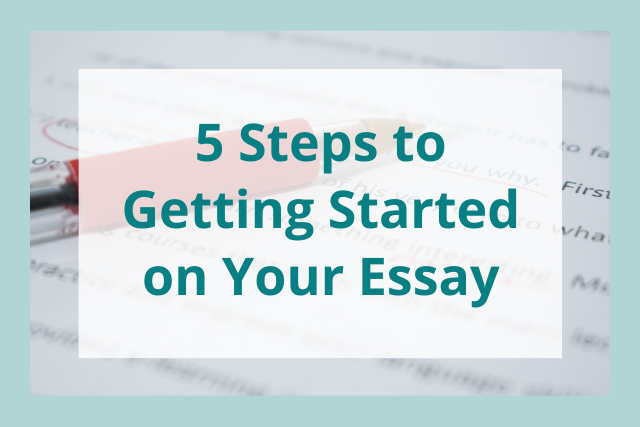
Many of you are probably familiar with the dread that accompanies receiving your essay topics. Nothing’s been written, nothing’s been thought of; all you have is a topic, a blank page, and the instruction to “write.” As a former high school English teacher, I’m convinced the anxiety of not knowing what to write is the reason why so many of my students wait until the last possible minute to write an essay. Under pressure, you have no choice but to get started. But by then, it’s too late to write the best essay you could've written.
The solution is to start as soon as possible. Apply this five step prep process to any essay you write.
Step 1: Free-write
Any writing is progress. Jot down anything about the topic you’ve been assigned, even if it’s just questions you have about what the prompt means. Jot down anything. Don’t censor yourself; just get your brain firing. If you are visual, you can draw pictures, symbols, or a rudimentary mind map (more on that below).
Step 2: Exploratory Research
If you're writing a research paper or anything requiring evidence to back up your points, do some exploratory research. It will acquaint you with the topic and perhaps reveal ideas you haven’t thought of yet.
On the computer, Google Scholar or Wikipedia are good places to get started. Simply search for the topics and ideas mentioned in the prompt and spend time doing some good old-fashioned internet surfing. If anything jumps out at you, jot it down, add it to a word document, take a screenshot, or bookmark the page—you may want to use it later for your essay. If you’re into old-fashioned research (or if your essay is about a specific book), head to the library, look up related topics in the catalog, and browse shelves related to your subject. When I wrote my dissertation, some of the best resources I found came from trying to find a specific book and then stumbling upon two or three even more awesome ones on the shelf nearby.
The reason I suggest doing exploratory research before any type of serious pre-writing or outlining is that nowadays it's easy to quickly access information on the web. In certain cases, you may want to avoid letting the opinions of others taint yours. Then again, you might find the ideas of others to be valuable to your development process. It's up to you.
Step 3: Pre-write
Now that you’ve searched, you can plan your essay.
There are two primary tried-and-true strategies for pre-writing: listing and clustering (also known as mind-mapping). If you choose the first, write down topics in a list and group related topics. If you choose the second, your prewriting will be more visual. Write down the essay topic in the center, circle it, then draw branches out to other ideas. Circle those ideas and keep branching out. The final result will look like a web.
Step 4: Deep Research
After pre-writing, you should have a more focused idea of what you are going to write about. Now you’re ready to get into some deeper research on the specific topics and ideas you mapped out in pre-writing. The amount of research you need to do might vary depending on the scope of the topic or the assignment. For example, you’ll have to do more research for a master’s thesis than a blog post. Take notes and connect them into the concepts in your pre-writing. Transfer your work to a computer, if you haven’t already done so, so you can easily shift headers and content.
Step 5: Outline Your Essay
Finally, it’s time to get organized. Based on your brainstorming and research, come up with your thesis (the focus of your essay). Start your outline with your central point, then list your supporting arguments underneath (these are going to be the topics of your body paragraphs). Underneath each of these supporting arguments, list examples and reasoning to support them.
For most students and most assignments, I suggest that you always get an initial structured outline down, but don’t agonize over making it perfect. Chances are, as you start writing, your thoughts may go in unexpected directions. So don’t devote too much time to an outline that may need to be changed.
How to Practice this Process
You can find many sample essay prompts online, but a good resource to practice with are these new ACT writing prompts (even if you aren’t preparing for the ACT). These persuasive writing prompts are great practice at any level because you can use them to either do a quick pre-write and outline without conducting additional research (meaning you can practice these skills in just a few minutes), or you can flesh them out with additional research to practice for longer essays.
Writing can be intimidating, but the longer you put an essay task off, the more daunting it becomes. Get started early, using this five-step process, and you will get to the finish line faster and with less agony.
Want to improve your essay writing skills?
Use ProWritingAid!
Are your teachers always pulling you up on the same errors? Maybe your sentences are too long and your meaning is getting lost or you're using the same sentence starter over and over again.
ProWritingAid helps you catch these issues in your essay before you submit it.

